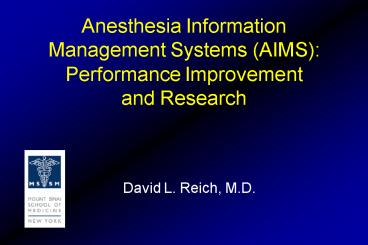Anesthesia Information Management Systems AIMS: Performance Improvement and Research
1 / 39
Title:
Anesthesia Information Management Systems AIMS: Performance Improvement and Research
Description:
Etiologies: missed readings, bad memory, bias against controversial #'s ... Preoperative Predictors of POF. Results. 2149 patients at two hospitals 93-'95 ... –
Number of Views:742
Avg rating:3.0/5.0
Title: Anesthesia Information Management Systems AIMS: Performance Improvement and Research
1
Anesthesia Information Management Systems
(AIMS)Performance Improvement and Research
- David L. Reich, M.D.
2
Differences between Handwritten and Automatic BP
Records
- Highest auto BP exceeded hand BP
- Lowest auto BP were lower
- 17/46 (37) had 3 auto BP hand
- No handwritten dBP 110
- Etiologies missed readings, bad memory, bias
against controversial s
Cook RI, McDonald JS, Nunziata E Anesthesiology
198971385-90
3
Automated Charting of Physiological Variables in
AnesthesiaA Quantitative Comparison of
Automated versus Handwritten Anesthesia Records
- TV,RR,EtCO2,FiO2,SpO2
- EFm 0.23-0.31, EFe 0.01-0.06
- sBP,dBP,HR
- EFm 0.08-0.13, EFe 0.05-0.11
- Induction EFm 0.62, EFe 0.26
- Emergence EFm 0.76, EFe 0.06
Lerou JG, Dirksen R, van Daele M et al J Clin
Monit 1988437-47.
4
Computer vs. Manual Records
5
Distribution of Cases
6
(No Transcript)
7
Systolic Arterial Pressure (mm Hg)
8
Vigilance
- 37 manual and 29 computer cases videotaped
- Tested random recall of physio data
- No difference between groups
- Measured recordkeeping time
- Manual 14.14.0
- Computer 12.4 4.0
- Allard J, Dzwonczyk R, Yablok D et al
- Br J Anaesth 199574619-26
9
Vigilance
- 9 residents in 36 cases
- Half handwritten records and half done by
assistant - Recordkeeping did not affect latency of response
time to simulated abnormal - Shorter cases had longer latency with manual
recordkeeping
Cook RI, McDonald JS, Nunziata E Anesthesiology
198971385-90
10
Task Analysis
- Observer categorized activities of 5 residents
during 12 CABG using computer or handwritten
records - Maintenance recordkeeping
- Computer 9.31.2, Hand 13.40.7
- p
- Computer group spent more time on direct patient
care (383 vs. 312)
Herndon OW, Weinger MB, Zornow MH, Gaba
DM Anesth Analg 199376S140 (abstract)
11
Pulse Oximetry Failure by Surgery Classification
12
Case Control Analysis of Pulse Oximetry Failure
and Temperature
X212.9, p 13
Case Control Analysis of Pulse Oximetry Failure
and Blood Pressure
P 14
Multivariate Logistic RegressionPreoperative
Predictors of POF
15
Results
- 2149 patients at two hospitals 93-95
- 50 mortalities (2.3)
- 51 strokes (2.4) (23.5 mortality)
- 85 MIs (4.0) (7.1 mortality)
- Multiple univariate predictors of death and
stroke and MI
16
Multivariate Predictors of Death
17
Multivariate Predictors of Death
18
Conclusions
- Specific intraoperative hemodynamic aberrations
are independently associated with death, stroke,
and MI - These findings demonstrate the prognostic
relevance of intraoperative hemodynamics over and
above the effects of preoperative risk factors - It is unclear whether outcomes could be improved
by greater control of intraoperative hemodynamic
variables
19
Methods
- Subjects (n797) from IRB-approved anesthesia
outcome study of patients undergoing major
noncardiac surgery. - Physiological component of the POSSUM determined
for each patient. - The computerized anesthesia record was retrieved
and intraoperative measurements of HR, MAP, and
SAP were obtained.
20
Categorization of MAP by Anesthesiologists
21
(No Transcript)
22
(No Transcript)
23
Negative Surgical Outcome in Noncardiac Surgery
24
Study Methods
- Anesthetic drug totals measured beginning 2 min
before through 2 min after the time recorded as
the anesthetic induction time - Patients were checked in the hospital computer
system for duration of postoperative hospital
stay and hospital discharge status - Doses of commonly used IV induction drugs were
normalized to body weight and classified
according to dosage range - propofol, etomidate, thiopental, midazolam, and
fentanyl
25
Preop Medical Rx
- Chronic preoperative medications into ten
categories - Diuretic, beta-blocker, calcium channel blocker,
ACE inhibitor, angiotensin receptor blocker,
other antihypertensive, thyroid replacement,
glucocorticoid, anti-depressant, and hypoglycemic - Proxies for the underlying medical conditions,
including diabetes mellitus and hypertension.
26
Hemodynamic Definitions
- Clinically important hypotension
- Pre-induction
- MAP
- Post-induction
- MAP decrease 40 AND MAP
- MAP
- Clinically important hypertension
- Pre-induction
- MAP 110 mm Hg
- Post-induction
- MAP increase 40 AND MAP 110 mm Hg
27
Prevalence of Hypotension Following Induction of
General Anesthesia
Note The denominators vary within groups based
upon completeness of data.
28
Relative Incidence of Hypotension at 0-5 Minutes
and 5-10 Minutes After Anesthetic Induction
ASA 1-2, n2824
McNemars Test, p
ASA 3-5, n1080
McNemars Test, p
29
Morbidity/Mortality Results
- 2406 patients with retrievable outcome and
hemodynamic data - Adverse events
- Postoperative stay 10 days
- Death during hospitalization
- Incidence of adverse events
- 13.3 with hypotension
- 8.6 without hypotension
- p0.012
30
Independent Predictors of Hypotension 0-10
Minutes Following Anesthetic Induction
Fentanyl dosing categories 1 0-1.50 µg/kg 2
1.51-5.00 µg/kg 3 5 µg/kg
31
Combinations of Independent Predictors Associated
with High Incidence of Hypotension 0-10 Minutes
Following Anesthetic Induction
32
Conclusions
- Remarkably high percentage of patients experience
clinically important hypotension following
anesthetic induction - It is prudent to consider alternatives to
propofol anesthetic induction in patients over 50
years with ASA 3 - It is prudent to avoid propofol induction in
patients with baseline MAP - The incidence of hypotension may be less when
lower doses of fentanyl are used at the time of
propofol induction
33
Cardiothoracic ORTurnover Time
Time
Period of analysis 12/01/96 through 02/28/97
34
OR Turnover Time (min)
35
Active ORs(hourly intervals)
36
(No Transcript)
37
(No Transcript)
38
(No Transcript)
39
(No Transcript)
40
Outcomes Query9/6/03-10/5/03































